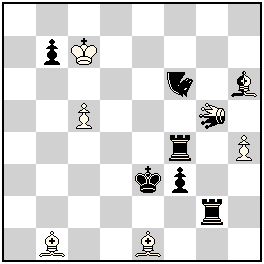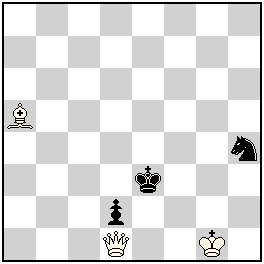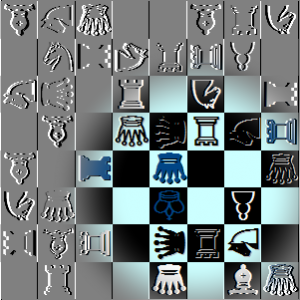|
|
Original Problems (page 7)I’ll publish some of my problems here and I’d be happy to receive yours! Diagrams, comments, new ideas, anything to discuss – are very appreciated! The site is mostly about fairies, but h# and s# are also welcome! Please send your problems to my e-mail: julia@juliasfairies.com Go to >>> Page 6; >>> Page 8 |
2 my own problems with neutral Locusts:
No.22 – h#2* by Julia Vysotska – in this problem I wanted to show some another option of Annihilation of neutral Locusts as forward battery-pieces (to compare with No.21, Page-6). But couldn’t find if there’s any definition of such a mechanism.
No.23 – h#2 by Julia Vysotska – interesting form of unpin in case of using Locust as a pinning piece, and also “unblock” of the squares around the black King to make them controlled by Locust.
And 2 problems without Locusts-theme:
No.24 – hs#2,5 – quite different unpin and black batteries in the joint problem by Julia Vysotska & Petko A.Petkov
No.25 – hs#4 by Mihail Croitor – a nice Miniature with surprising play.
See the all Definitions in Fairy Terms section or click the fairy piece or condition below to go right to its definition on that page:
|
–
No.22 Julia Vysotska
(Latvia)
original
–
 h#2* (2+5+4)
Neutral Locusts: e6, e7
Neutral Grasshopper e8
–
Solution:
Setplay 1…nSf8*e6 2.nSe6-c7 nLe7*c7-b7 #
1.nSf8-g6 nSg6*e7 2.nSe7-d5 nLe6*d5-c4 #
–
A special form of half-battery play (pseudo half-battery play) – Neutral S transforms a half-battery into a battery by capturing (with Annihilation effect) one of nLo and leaving the battery line with a further sacrifice to another nLo.
Interchange of functions between Locusts. Meredith. (Author)
|
–
No.23 Julia Vysotska
(Latvia)
original
–
 h#2 b) Black Sf4 (5+6+2)
Black Nightrider f6
Neutral Locust g5
–
Solution:
a) 1.Rd2 Bg3 2.Rfd4 LOn×f6-e7 #
b) 1.Nd2 c6 2.Se2 LOn×g2-g1 #
–
A special form of unpin of Rf4/Sf4 by blocking the square after the King on the line. Play of masced neutral battery. White moves “unblock” the squares around the black King to make them to be controlled by nLo in the mate position. Interchange of functions between black Nf6 and Rg2. (Author)
|
|
–
No.24 Julia Vysotska & Petko A.Petkov
(Latvia, Bulgaria)
original
–
 hs#2,5 2 solutions (5+9)
White Nightrider f1
White Grasshopper d1
–
Solution:
I. 1…Rg2 2.Ng3! (tempo-move!) e×d1=G 3.Nh5+ G×h5 #
II.1…Ra2 2.Gf3! (tempo-move!) e×f1=N 3.Gd5+ N×d5 #
–
Unpin of white G and N, which makes surprising tempo-moves. Realizing this unpins, the black Rooks demonstrate also ambush-moves with a goal – control on f2/d2. Creation of black batteries through reciprocal under-promotions into G and N. (Authors)
|
–
No.25 Mihail Croitor
(Moldova)
original
–
 hs#4 2 solutions (3+3)
–
Solution:
I. 1.Kh2 Kf2 2.Qh1 d1=Q 3.Bd2 Qh5 4.Qg2+ Sxg2#
II. 1.Qc2 Ke2 2.Bc7 Ke1 3.Bh2 d1=R 4.Qe2+ Kxe2#
–
|
Echecs font of WinChloe is used for Logo design



N 22 Julia Vysotska. A new, very nice h#2 from Julia! In my opinion, in theoretical aspect, it is not so easy to formulate the main theme here. Probably there are some arguments to call this combination “play of pseudo half-battery” , but I wouldn`t like to perceive categorically this terminology.
Presumably, it is more correct to define this theme as: “Play of special masced battery with two forward pieces – A and B, which execute reciprocal functions as masced figures and which are destroyed with Annihilation effect”. Certainly, this Thematic is possible too in orthodox helpmates.
In Julia`s N 22 very fresh and interesting motive is play of the neutral S which makes 5 (!) half-moves in both phases – a surprising activity!
I think, that here the formula set-play+real play is better as 2 solutions which (probably) we can create, using an other black, neutral or half-neutral capturing piece.
No.23 is a nice idea but wBe1 is hard to employ in 2nd phase. Thematic “unblock” of the squares around the black King to make them to be controlled by nLo in the mate position may be changed into a thematic avoidance of such “block”. The guard of the flight (e2/d4 ) by one wN in a try must be delegated to the other wN, with the reciprocity of twins. Example:
White Kb7 Na2 Nd1
Black Sa7 Ne6 Re4 Kd3 Pe3 Rf2
h#2; b) Black Se4
1.Rf2-c2 Nd1-c3! 2.Re4-c4 nLf5*e6-d7#
If 1… Na2-c3? then 3.Kd2!
1.Ne6-c2 Na2-c6! 2.Se4-d2 nLf5*f2-f1#
If Nd1-b5? then 3.Kc4!
Nikola, thanks for correcting my comment! I appreciate it a lot as sometimes I can’t find the right way to express what’s going on.. I like how you put it as “thematic avoidance of such “block”.
Looking at your example – you don’t have neutral pieces in your notation above, but I guess it’s: nLof5 nBh7
It’s not C+. Is this a scheme? Or have I missed anything on the diagram?
Your solutions are a bit different: in a) Nd1 must make a move to avoid a “block” of d2 for nLo, but in b) Nd1 can’t move on b5 as it would make such “block” on c4. I don’t mind it. I even like to use the same approach sometimes. I’ll look at it one more time tonight…
N.24 is very original with nice unpins, battery formation and surprise white tempo moves!
Oh, I’m sorry. I copied W+B pieces from Popeye input forgetting that neutral pieces are neither white nor black :)). nL is indeed on f5 but nB is on g6 (and cooks ending with 2…nLxe4-d3+ do not work because of 3.nLd3xg6-h7).
Main trouble in your problem is the superflouos Be1 in b). wPc5 is supeflouos in a) – it’s tolerable because it is a Pawn but full purpose of any piece is preferable. (And wPh4 is not a bonus).
Example essencially shows your idea without superflouos pieces, but it is just an illustration which certainly needs improving. Orthodox wSd1 would be enough for the solutions but there would be no try in b) (1…Nd1-b5) so wNd1 is relatively superflouos (more powerful than is needed for mates).
Another possible improvement is to try 2 solutions form. In a different scheme, bR could make selfblocks on c4 and d4 (in example) or d4 and e4 (in your problem) and there would be no need for twins.
Of course all improvements require some work but I believe they are possible.
Ok, it works now:
[img]http://www.ankona.ch/diagrams/99881.png[/img]
a) 1.Rf2-c2 Nd1-c3 2.Re4-c4 nLf5*e6-d7 #
b) bSe4: 1.Ne6-c2 Na2-c6 2.Se4-d2 nLf5*f2-f1 #
Thank you for all your comments! I’ll think about the possible improvements!
(your problems for the site are also very welcome!)
Mihail Croiter’s problem is very good. Surprising change of black batteries and promotions. Excellent miniature.